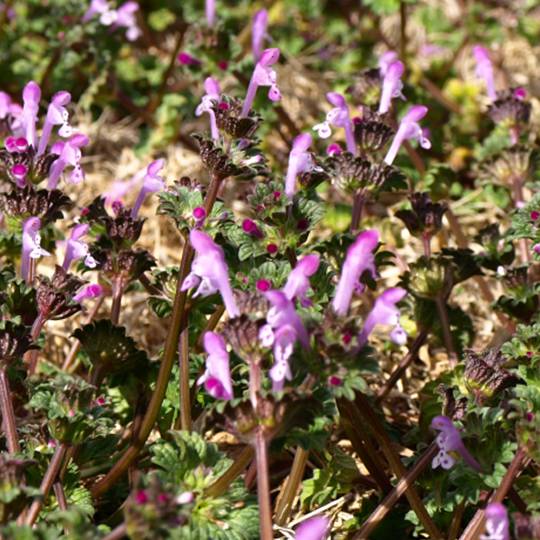
Henbit (lamium amplexicaule) and purple deadnettle (lamium purpureum) are commonly known as greater henbit (henbit), giraffe head (henbit), and purple archangel (purple deadnettle). Stemming from the lamiaceae family, these broadleaf weeds are similar to each other, each having small, horn-shaped purple flowers growing out of the top of their long stems. Healall is another similar weed, also part of the lamiaceae family.
Though they look alike and often grow together, henbit and purple deadnettle are different broadleaf weeds. Both grow in similar environments and, because they are a part of the mint family, it is believed that both were smuggled to the United States as a food prior to becoming the invasive weeds now known for infecting lawns.
The main difference between the two weeds? The flower stems of purple deadnettle leaves have stalks on them while henbit leaves don’t. The leaves are a centimeter or two apart and circle the stem of the plant. Found aesthetically pleasing by some, both henbit and purple deadnettle are sometimes left alone when they grow in gardens. In a poorly maintained garden, however, their invasive, aggressive nature can help the weeds spread and prevent a green lawn.
Henbit and Purple Deadnettle Prevention
Henbit and purple deadnettle are winter annuals. This makes these particular weeds more difficult to control. Pre-emergent herbicides have proven to be the most effective method of prevention, while spread can be controlled by mulch. Dense, healthy turf with deep roots can often choke out both henbit and purple deadnettle and other similar broadleaf weeds.
Contact Cardinal Lawns if your lawn is struggling with either of these broadleaf weeds. We can also assist with applying a pre-emergent herbicide and help your lawn reach its full potential.
Need Help with Henbit and Purple Deadnettle?
Call Cardinal Lawns today at 614-808-4446 and let's talk about how we can help treat for Henbit and Purple Deadnettle and other common Ohio lawn weeds.
Get a Free Quote